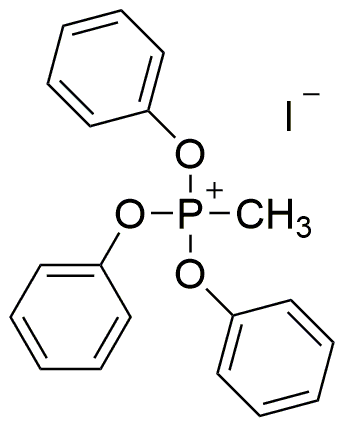Methyltriphenoxyphosphonium iodide is widely utilized in research focused on:
- Organic Synthesis: This compound serves as a versatile reagent in organic chemistry, facilitating the synthesis of various organic molecules, particularly in the formation of phosphonium salts.
- Pharmaceutical Development: It plays a role in drug discovery, where it can be used to modify drug compounds for improved efficacy or solubility, aiding in the development of new therapeutic agents.
- Material Science: Methyltriphenoxyphosphonium iodide is applied in the formulation of advanced materials, including polymers and coatings, enhancing their properties such as thermal stability and chemical resistance.
- Biological Research: Researchers utilize this compound in studies related to cell signaling and membrane dynamics, helping to understand cellular processes and develop new biotechnological applications.
- Environmental Chemistry: It is also explored for its potential in environmental applications, such as in the remediation of pollutants, due to its ability to interact with various chemical species in the environment.
General Information
Properties
Safety and Regulations
Applications
Methyltriphenoxyphosphonium iodide is widely utilized in research focused on:
- Organic Synthesis: This compound serves as a versatile reagent in organic chemistry, facilitating the synthesis of various organic molecules, particularly in the formation of phosphonium salts.
- Pharmaceutical Development: It plays a role in drug discovery, where it can be used to modify drug compounds for improved efficacy or solubility, aiding in the development of new therapeutic agents.
- Material Science: Methyltriphenoxyphosphonium iodide is applied in the formulation of advanced materials, including polymers and coatings, enhancing their properties such as thermal stability and chemical resistance.
- Biological Research: Researchers utilize this compound in studies related to cell signaling and membrane dynamics, helping to understand cellular processes and develop new biotechnological applications.
- Environmental Chemistry: It is also explored for its potential in environmental applications, such as in the remediation of pollutants, due to its ability to interact with various chemical species in the environment.
Documents
Safety Data Sheets (SDS)
The SDS provides comprehensive safety information on handling, storage, and disposal of the product.
Product Specification (PS)
The PS provides a comprehensive breakdown of the product’s properties, including chemical composition, physical state, purity, and storage requirements. It also details acceptable quality ranges and the product's intended applications.
Certificates of Analysis (COA)
Search for Certificates of Analysis (COA) by entering the products Lot Number. Lot and Batch Numbers can be found on a product’s label following the words ‘Lot’ or ‘Batch’.
Numéro de catalogue
Numéro de lot/série
Certificates Of Origin (COO)
This COO confirms the country where the product was manufactured, and also details the materials and components used in it and whether it is derived from natural, synthetic, or other specific sources. This certificate may be required for customs, trade, and regulatory compliance.
Numéro de catalogue
Numéro de lot/série
Safety Data Sheets (SDS)
The SDS provides comprehensive safety information on handling, storage, and disposal of the product.
DownloadProduct Specification (PS)
The PS provides a comprehensive breakdown of the product’s properties, including chemical composition, physical state, purity, and storage requirements. It also details acceptable quality ranges and the product's intended applications.
DownloadCertificates of Analysis (COA)
Search for Certificates of Analysis (COA) by entering the products Lot Number. Lot and Batch Numbers can be found on a product’s label following the words ‘Lot’ or ‘Batch’.
Numéro de catalogue
Numéro de lot/série
Certificates Of Origin (COO)
This COO confirms the country where the product was manufactured, and also details the materials and components used in it and whether it is derived from natural, synthetic, or other specific sources. This certificate may be required for customs, trade, and regulatory compliance.


